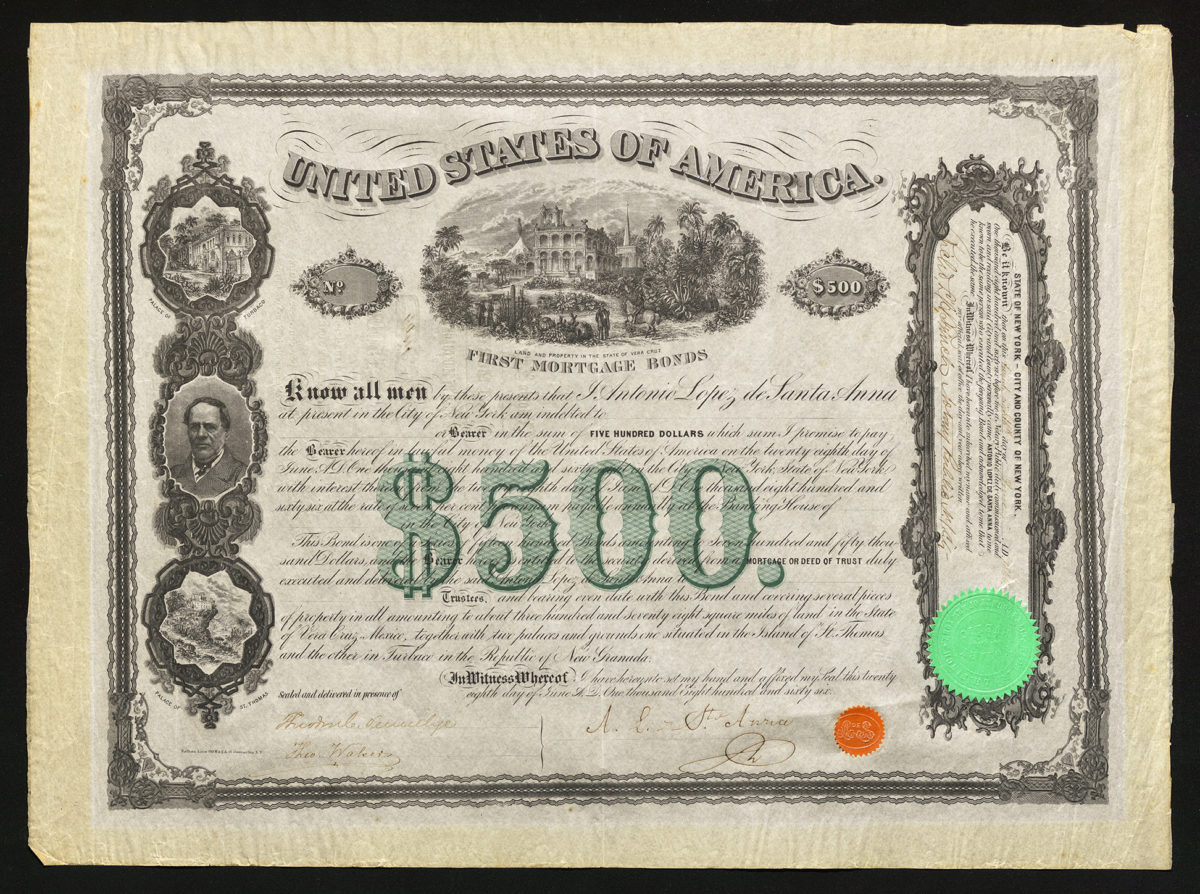
Generalisimo Santa Anna Attempts a Coup
After realizing he had been bamboozled, a desperate and determined Santa Anna sold bonds to raise the funds to finance his coup attempt. These bonds became worthless when Santa Anna was captured by the Mexican government and sent into exile.
Header Image: Santa Anna, military leader; author Carlos Paris courtesy of Wikimedia Commons [1].
“Increasingly lost in a labyrinth of his own making... Santa Anna was desperate to believe that he was being urged to intervene”

Combat de Vera Cruz 1838 Prince de Joinville attaque la maison du general Arista; author Blanchard Henry Pierre Léon Pharamond courtesy of Wikimedia Commons
General Antonio López de Santa Anna’s rule of Mexico was tumultuous. He held the presidency on eleven separate occasions—a position that frequently ended in his exile. The annexation of the Republic of Texas as the 28th state in the Union in December of 1845 had spurred the Mexican-American War of 1846-1848, where Mexican forces led by Santa Anna were defeated. Santa Anna went into exile but returned to claim the Mexican presidency once more before being exiled again in 1855.
It was during this time in exile, while living in St. Thomas, that Santa Anna fell victim to two con-men, Darío Mazuera and Abraham Báez. The two men convinced Santa Anna that American Secretary of State William H. Seward was interested in backing operations to depose the Emperor of Mexico, Maximillian I, and retake the presidency from Benito Juárez. This deception involved letters forged in Seward’s name, asking Santa Anna to come to Washington to organize the overthrow of the French-controlled Mexican government while promising $30 million in financial backing for the venture.
Santa Anna did not question the veracity of these letters, perhaps because he was too eager for it to be true; his swindlers certainly knew how obsessed Santa Anna was with returning to Mexico. He immediately moved to New Jersey—paying Mazuera and Báez grossly inflated prices to procure a ship and housing—only to find that Seward had never written to him, and the U.S. government was in full support of Mexican President Benito Juárez.
After discovering the ruse, Santa Anna was in a weak financial position, but he was also more determined than ever to see his mission through. In order to raise the necessary funds, in 1866 he issued a series of 1,500 mortgage bonds—like this one—in the amount of $500, for $750,000 total. The bonds were backed by Santa Anna’s properties, sketches of which are printed on the bond: the palaces of Turbaco, St. Thomas, and Vera Cruz (never mind that the latter property had been confiscated by President Juárez). The bond also features a portrait of Santa Anna, depicted in a business suit as opposed to more common images of him in military uniform. (Scroll down to continue reading about Santa Anna below)
Following the death of Emperor Maximillian in 1867, Santa Anna’s expedition landed in Mexico, but his plans were thwarted as he was captured and sentenced to death by President Juárez. He was spared execution and went into exile one final time. The bonds that had been issued were never cancelled, as repayment had been contingent on Santa Anna’s return to power. It is believed that many of the original 1,500 bonds were destroyed when investors realized they were worthless.
Santa Anna was able to return to Mexico in 1874, by a government that no longer considered him a threat; he was nearly blind, crippled by the loss of one leg, and living in poverty. He died two years later at the age of 82.
 University of Nevada, Reno
University of Nevada, Reno
